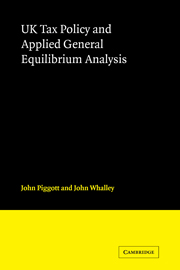Book contents
- Frontmatter
- Contents
- PREFACE
- ACKNOWLEDGEMENTS
- INTRODUCTION AND SUMMARY OF STUDY
- PART I The General Equilibrium Model of the UK – Structure, Data and Model Solution.
- CHAPTER 1 General Equilibrium Analysis of Tax and Subsidy Policies
- CHAPTER 2 The Basic Variant General Equilibrium Model
- CHAPTER 3 Model Treatment of UK Taxes, Subsidies and Government Expenditure
- CHAPTER 4 Calibrating the model
- CHAPTER 5 Benchmark Equilibrium Data Set
- CHAPTER 6 Specifying Values for Substitution Elasticities
- PART II Empirical Analysis of the UK Tax/Subsidy System Using the General Equilibrium Model
- SUMMARY AND CONCLUSIONS
- APPENDIX A Structure of the Basic Variant Model
- APPENDIX B Notes to Tables Appearing in Chapter 5
- APPENDIX C Notes on Programming and Computation
- BIBLIOGRAPHY
CHAPTER 2 - The Basic Variant General Equilibrium Model
Published online by Cambridge University Press: 04 August 2010
- Frontmatter
- Contents
- PREFACE
- ACKNOWLEDGEMENTS
- INTRODUCTION AND SUMMARY OF STUDY
- PART I The General Equilibrium Model of the UK – Structure, Data and Model Solution.
- CHAPTER 1 General Equilibrium Analysis of Tax and Subsidy Policies
- CHAPTER 2 The Basic Variant General Equilibrium Model
- CHAPTER 3 Model Treatment of UK Taxes, Subsidies and Government Expenditure
- CHAPTER 4 Calibrating the model
- CHAPTER 5 Benchmark Equilibrium Data Set
- CHAPTER 6 Specifying Values for Substitution Elasticities
- PART II Empirical Analysis of the UK Tax/Subsidy System Using the General Equilibrium Model
- SUMMARY AND CONCLUSIONS
- APPENDIX A Structure of the Basic Variant Model
- APPENDIX B Notes to Tables Appearing in Chapter 5
- APPENDIX C Notes on Programming and Computation
- BIBLIOGRAPHY
Summary
The general equilibrium analysis of taxes and subsidies in the preceding chapter gives little indication as to how such a framework can be made operational. For a model of an actual economy to be used to analyze policy alternatives, a specific structure along with functional forms must be chosen, and parameter values selected. In this chapter the model of the UK is discussed. It is calibrated (or benchmarked) to a 1973 ‘equilibrium’ data set, the latest year available for much of the data at the time of its construction (1975-1977). The methods used to determine parameter values are discussed in Chapter 4.
The basic variant is a fixed factor supply, static general equilibrium model which abstracts from intertemporal tax distortions and distortions of labour supply. In Chapter 9 we describe a number of model extensions which analyze tax distortions of labour supply and savings. Chapter 9 also includes a model variant where government expenditures reflect household preferences towards public goods.
Results portray tax distortions of factor supplies as being relatively mild (in terms of distorting costs) compared to some of the commodity and industry tax distortions. Welfare loss estimates from savings distortions, however, are dependent on assumptions about inflation and savings elasticities, and in recent literature (such as Summers [1980]) large effects from this distortion were reported. The combination of convenience and model results provide the reasons for partitioning our model presentation in this way, with a basic structure presented here and the various model extensions later.
- Type
- Chapter
- Information
- UK Tax Policy and Applied General Equilibrium Analysis , pp. 35 - 63Publisher: Cambridge University PressPrint publication year: 1985



